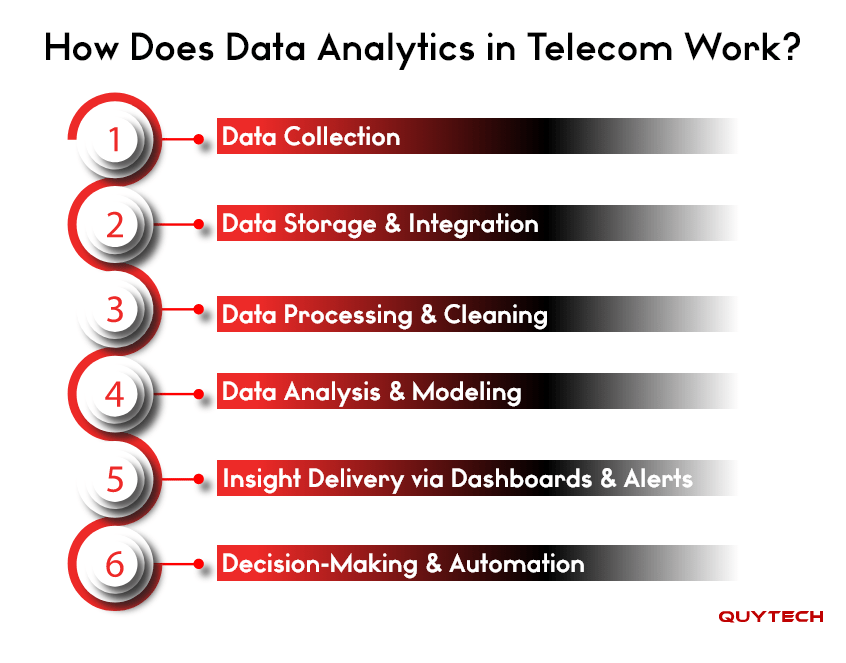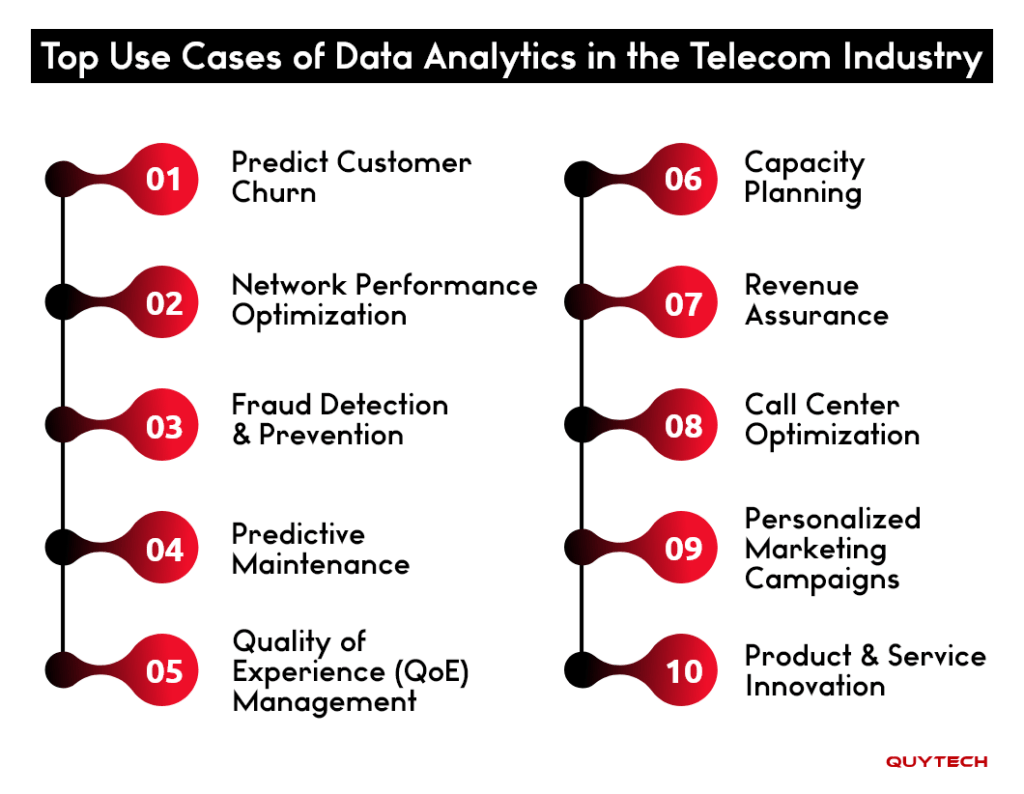In the telecom industry, operators deal with vast volumes of data, from millions of daily calls to text messages, every second.
However, this data is not just traffic, but it holds the capability to provide crucial insights that can make customer experiences better, facilitate smarter decision-making, and improve operational efficiency. All these goals can be achieved using data analytics.
That’s the reason most telecom companies are investing heavily in implementing data analytics in their systems so that they can collect and analyze data and gain useful insights to achieve the previously stated goals.
If we look at the reports from 2024, it shows that the size of global big data analytics in the telecom sector was valued at $3.6 billion. Moreover, it is estimated that the market will grow at a CAGR of 18.3% between 2025 and 2034.
Source: GM Insights
This rapid growth signals how essential data analytics has become in driving the telecom industry forward, understanding customers better, and improving telecom services at a time when competition is intensifying and customer expectations are at an all-time high.
So, in this blog, we have explained how data analytics is transforming the telecom industry, its working, key benefits, real-world use cases, challenges, and how you can get started. Let’s dive in.
What is Data Analytics in Telecom?
Data analytics is the process of analyzing large volumes of data to recognize patterns, trends, and insights that can help in improving telecom services and enhancing customer experiences.
It converts raw and unstructured data into actionable and valuable information, using which telecom companies can solve industry-specific problems, improve performance, and even predict future outcomes. Data analytics has four main components, listed below:
- Descriptive Analytics: Understands what event has happened in the past. For example, dropped call rates last month.
- Diagnostic Analytics: Explains why the event happened. For example, network congestion in specific regions.
- Predictive Analytics: Forecasts what is likely to happen. For example, which customers might churn next?
- Prescriptive Analytics: Recommends actions to take to make the situation better. For example, the best time to offer discounts or upgrade plans.
For telecom businesses, data analytics helps in making data-informed decisions for better accuracy, speed, and results, rather than just making decisions based on assumptions.
How Does Data Analytics in Telecom Work?
In this section, you will explore how data analytics in the telecom industry works.

- Data Collection
Telecom operators collect structured and unstructured data from various sources, such as mobile networks, customer service platforms, billing systems, IoT sensors, CRM tools, and social media interactions. Usually, the collected data includes everything from usage patterns and device types to network status and customer feedback.
- Data Storage & Integration
The collected data is then stored in centralized systems such as cloud-based data lakes or big data platforms. To make data analytics work as per the expectations, it is necessary that the data from different departments, such as network, customer care, and finance, can work together to give a unified view of performance and behavior.
- Data Processing & Cleaning
The data is cleaned and standardized before being used for the analysis. Data analysts fix the inconsistent formats, duplicate entries, or missing fields to ensure the accuracy of insights. This step is critical in data analytics as it eliminates noise and makes the data analysis-ready.
- Data Analysis & Modeling
This is a crucial stage. Data is analyzed using statistical tools, machine learning algorithms, and AI models to gain useful insights. For instance, predictive analytics is implemented to forecast customer churn or detect early signs of network congestion, and pattern recognition helps with identifying fraudulent activities, and clustering models segment users based on behavior.
- Insight Delivery via Dashboards & Alerts
The insights are then visualized through dashboards, reports, and real-time alerts. Network engineers can view current traffic load, marketers can track campaign performance, and executives can monitor KPIs, all from a centralized interface.
- Decision-Making & Automation
The final stage is decision-making. These insights are used to take actions, such as deploying automated network fixes, launching targeted marketing campaigns, optimizing resource allocation, or improving customer support workflows. In many cases, artificial intelligence is used to enable these actions automatically when the metrics are met.
Benefits of Data Analytics in the Telecom Sector
Data analytics in telecom provides various advantages to telecom businesses, such as the following.
- Improved Customer Retention
Data analytics helps telecom companies improve customer retention. With the help of data analytics, they analyze customer behavior, usage trends, and service feedback, and predict which users are likely to churn.
With this foresight, telecom operators implement targeted retention strategies, like personalized offers or service improvements, proactively to reduce customer turnover.
- Optimized Network Performance
Another advantage of implementing data analytics in telecom is that it helps telecom companies optimize their network performance. Data analytics enables real-time monitoring of network traffic, bandwidth usage, and equipment health.
Using the insights, telecom operators can identify areas for improvement, predict network outages, and allocate resources more effectively to ensure better service availability and reduced downtime.
- Better Decision-Making
Better decision-making is among the top advantages of data analytics in the telecom industry. Data analytics collects a high volume of telecom data and provides useful insights.
Different departments in the telecom business can use these actionable insights to make more confident decisions, which can be beneficial for both the business and customers.
- Enhanced Revenue Opportunities
Telecom businesses can enhance their revenue opportunities by implementing data analytics. With insights from customer segmentation and usage patterns, telecom providers can design personalized upsell and cross-sell campaigns for their customers.
These relevant offers, which are more likely to resonate with customers, not only increase the telecom business’s Average Revenue Per User (ARPU) but also enhance customer satisfaction.
- Competitive Advantage
Using data analytics, telecom operators can respond quicker to trends, launch smarter products, and deliver better user experiences.
This proactive approach gives them a clear edge over their rivals, who still rely on making decisions based on their gut feeling or outdated methods.
Top Use Cases of Data Analytics in the Telecom Industry
The following are the top ways businesses, operators, and companies use data analytics in the telecom industry.

- Predict Customer Churn
One of the top use cases of data analytics in telecom is to predict customer churn. Telecom companies use predictive data analytics to identify customers likely to churn based on usage patterns, complaints, and service history.
With this data analysis, telecom operators proactively offer personalized retention plans to reduce churn rates and improve customer lifetime value.
- Network Performance Optimization
In the telecom sector, data analytics helps operators monitor real-time network key performance indicators (KPIs), such as latency, jitter, and packet loss, to identify congestion or coverage issues.
Telecom businesses apply data analytics to traffic patterns and usage trends to optimize bandwidth allocation, improve QoS (Quality of Service), and enhance overall network reliability, especially in advanced IoT environments and 5G.
- Fraud Detection and Prevention
Fraud detection and prevention is another application of data analytics in the telecom industry. Telecom providers use anomaly detection and machine learning to spot fraudulent activities like SIM swap fraud, call spoofing, subscription abuse, and more.
Data analytics is implemented to analyze call records, geolocation data, and transaction logs in real time, trigger alerts, and block threats instantly, saving revenue and maintaining customer trust.
- Predictive Maintenance
Telecom businesses and operators leverage data analytics to monitor infrastructures like base stations and fiber nodes, and predict early signs of failure.
Data analytics helps telecom companies to use and analyze historical and sensor data to forecast potential breakdowns before they happen.
Once telecom companies get to know, they take preventive actions to reduce downtime and lower the maintenance costs while improving the service continuity.
- Quality of Experience (QoE) Management
Leading telecom companies and operators rely on data analytics to manage quality of experience (QoE). Operators use real-time data analytics from devices and applications to monitor customer experience across services like video streaming or VoIP.
Telecom operators use these insights to fine-tune network performance and content delivery, improving user satisfaction and reducing complaints.
- Capacity Planning
The capacity planning is among the top use cases of data analytics in the telecom sector. Data analytics helps telecom companies to forecast future demand by analyzing historical usage, seasonal patterns, and subscriber growth.
This helps telecom companies to strategically plan for the installation of new cell towers, data centers, or spectrum allocation, ensuring the network scales efficiently as demand rises.
- Revenue Assurance
Data analytics helps telecom operators and companies identify gaps in billing, incorrect charges, or missed revenue from underused services.
Operators compare data from CRMs, billing systems, and usage records, using data analytics, and get insights about how they can minimize the revenue leakage, boost financial performance, and ensure compliance.
- Call Center Optimization
Telecom operators leverage data analytics for speech analytics and customer sentiment analysis to improve call center performance.
Telecom companies identify common issues by analyzing recorded conversations and support ticket data.
Based on the analysis, they take actions to automate resolutions and improve their agent training, which leads to quick resolution times and better customer satisfaction.
- Personalized Marketing Campaigns
Using data analytics, telecom businesses segment users based on behavior, preferences, and demographics. Based on the segmentation, they create personalized offers and marketing campaigns that resonate with specific user groups.
Behavioral data analytics in telecom improves campaign ROI, increases ARPU, and enhances customer engagement with more relevant and timely promotions.
- Product and Service Innovation
Last but not least, data analytics helps telecom companies innovate new products and services for their customers.
By analyzing customer behavior, feedback, and market trends, telecom operators identify unmet needs and develop new data plans, digital services, or OTT (Over-the-Top) bundles.
This approach of data-driven product innovation reduces risk and aligns new offerings with actual customer demand, significantly benefiting telecom companies.
You Might Be Interested In: AI in Telecom: Use Cases, Benefits, And More
Challenges in Implementing Data Analytics in Telecom Business ( And How to Overcome Them)
While data analytics offers massive benefits to telecom companies, implementing it successfully, many times, isn’t smooth. There are some common challenges that you may face while implementing it into your business, along with their solutions.
- Handling Massive Data Volumes
Telecom networks generate enormous amounts of data every second, making it difficult for you to store, manage, and analyze efficiently.
Solution: You can tackle this challenge by adopting scalable big data platforms and using cloud-based infrastructure to handle real-time data streams without bottlenecks.
- Integrating Data from Multiple Systems
In telecom, data is often scattered across different systems, such as CRM, billing, OSS/BSS, and network logs, which makes it hard to collect and get a unified view.
Solution: To get a unified view, you can use data integration tools and APIs to bring all your data into a centralized data lake, enabling more accurate and holistic analytics.
- Ensuring Data Quality and Consistency
If you collect and analyze inconsistent or incomplete data, it will lead to unreliable insights and wrong decisions, negatively impacting your business.
Solution: You can ensure data quality by setting up strong data governance practices, regular data cleaning routines, and validation checks.
- Lack of In-House Data Analytics Expertise
You may not have skilled data scientists or AI experts to build and manage data analytics models for your telecom business.
Solution: You can hire data scientists and data analysts to develop and manage data analytics solutions.
- Data Security and Privacy Risks
With customer data involved, there’s always a risk of breaches or non-compliance with data privacy regulations like GDPR.
Solution: You can implement strong data encryption, access controls, and compliance frameworks to protect sensitive data from unauthorized access and build user trust.
Top Telecom Operators Using Data Analytics In Their Operations
The following are the top telecom businesses that are using data analytics for different purposes.
- AT&T
AT&T relies on data analytics to monitor and optimize its vast network infrastructure in real time. The company has integrated AI/ML into its service assurance layer to enable predictive fault detection and auto-remediation across its IP/MPLS backbone and 5G RAN infrastructure.
Moreover, AT&T’s predictive analytics models use telemetry data from OSS/BSS and network elements to predict potential outages and proactively resolve issues before customers are affected across the United States.
- Verizon
Verizon, another American telecommunications company, has implemented advanced data analytics models to tackle telecom fraud and prevent financial losses.
They utilize advanced CEP (Complex Event Processing) frameworks layered on top of their CDR and signaling data streams to detect anomalous behaviors indicative of fraud, like SIM swap attacks, international toll fraud, and subscription cloning.
- China Mobile
China Mobile uses predictive data analytics to manage bandwidth allocation across its vast user base of over 900 million subscribers.
Their Autonomous Network (AN) initiative applies AI-driven analytics to orchestrate dynamic resource allocation across the 5G NR layer and EPC.
Their data analytics models forecast user traffic loads based on geospatial patterns, time-of-day profiles, and network KPI trends to dynamically reallocate resources to ensure a smooth user experience even during peak times.
- Deutsche Telekom
The Germany-based telecom company, Deutsche Telekom, applies data analytics through its T-Mobile brand to collect customer behavior data and improve personalization.
The company uses data analytics to study how individual users interact with their mobile plans, streaming habits, and device usage.
Based on the analysis, the Deutsche Telekom dynamically generates micro-segmented offers and optimizes content delivery via adaptive bitrate streaming, reducing video buffering and improving MOS (Mean Opinion Score) for media-heavy users.
- Vodafone Group
Vodafone, a British multinational telecommunications company, is actively using data analytics to manage its Internet of Things (IoT) services, particularly in sectors like logistics and smart cities.
Vodafone has deployed ML inference models at the network edge (using MEC) to detect anomalies such as sensor drift, unauthorized access attempts, or device malfunctions in real-time.
How Quytech Can Help You Get Started With Data Analytics in Telecom Business
Quytech is a specialized data analytics company that develops advanced solutions powered by AI, machine learning, and other technologies for the telecom sector.
We have been delivering custom data analytics services to telecom operators, enterprises, and startups and helping them achieve their business goals, such as improving customer retention, optimizing network operations, detecting fraud, and others.
When partnered with us, you can expect the following sequence of actions to empower your telecom business with advanced data analytics.
- Strategy & Discovery
We will start with consultations to understand your business goals, challenges you are facing, and your existing business infrastructure. Our experts will conduct a detailed discovery session to identify high-impact data opportunities in your telecom environment.
- Data Assessment & Integration Planning
We audit your current data landscape, such as CDRs, CRM, billing systems, OSS/BSS, etc., to identify sources, gaps, and integration needs. Our team then plans how to collect and clean your data for analytics implementation.
- Custom Analytics Solution Design
Based on your use cases, such as churn prediction, network fault analytics, or fraud detection, our data engineers will design tailored AI/ML models and data workflows that align with your KPIs and compliance requirements.
- Development & Deployment
In this stage, we will build your solution using an advanced technology stack and then deploy it securely, either on-premises, in the cloud, or on a hybrid infrastructure.
- Continuous Support & Optimization
Post-deployment, our team will monitor performance, fine-tune models, and provide ongoing support to adapt your data analytics system as your telecom business scales or new requirements emerge.
Conclusion
Data analytics has become a necessity in the modern telecommunication industry. It helps telecom companies to analyze vast amounts of data and pick useful insights from it.
With this information, telecom companies can improve their network services, make better data-driven decisions, create personalized services and products for their customers, and create action plans for the future.
However, implementing data analytics in the telecom industry is not as easy as it looks. You might face many challenges related to implementation, data quality, privacy and security, handling data, analytics expertise, and more.
But don’t worry, partner with Quytech, and we will help you implement data analytics into your telecom business successfully while overcoming every challenge like an expert. We had already done this with 30+ telecom operators and companies worldwide, now it is your turn. Contact us today.
Frequently Asked Questions
For your telecom business, data analytics is crucial because it helps you understand customer behavior, optimize network performance, reduce churn, detect fraud in real time, and enable smarter, faster decisions that improve service quality and drive revenue growth.
On average, a custom telecom analytics solution development can range from $25,000 to $150,000 or more. Please note that the actual costs can vary depending on complexity, features, data volume, infrastructure, and other factors.
At Quytech, we use a combination of techniques, including predictive analytics, machine learning, anomaly detection, clustering, sentiment analysis, and real-time data processing to deliver accurate, actionable insights tailored for telecom needs.
Reach out to Quytech, the best data analytics services provider, and we will develop data analytics software for your telecom business.



